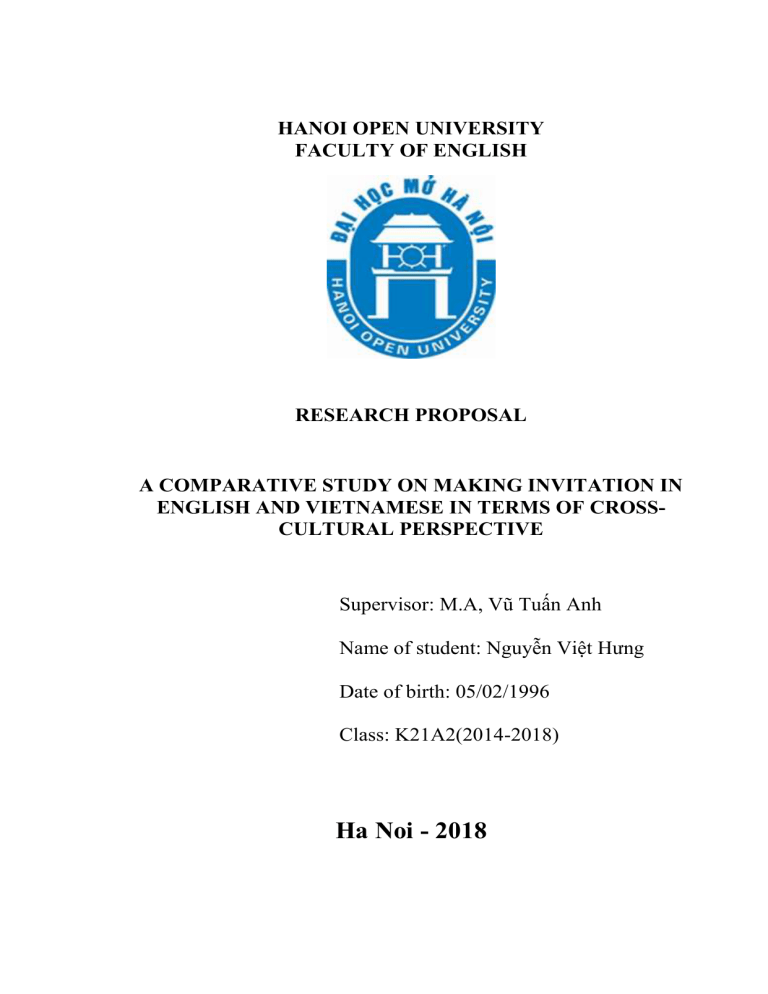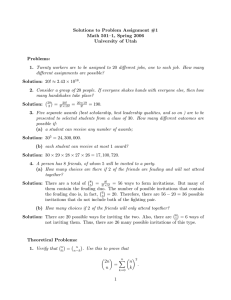English-Vietnamese Invitation Study: Cross-Cultural Pragmatics
advertisement

HANOI OPEN UNIVERSITY FACULTY OF ENGLISH RESEARCH PROPOSAL A COMPARATIVE STUDY ON MAKING INVITATION IN ENGLISH AND VIETNAMESE IN TERMS OF CROSSCULTURAL PERSPECTIVE Supervisor: M.A, Vũ Tuấn Anh Name of student: Nguyễn Việt Hưng Date of birth: 05/02/1996 Class: K21A2(2014-2018) Ha Noi - 2018 1.Rationale There is no doubt that today mastering a language is very necessary because it can give learners important opportunities to communicate to study and work effectively abroad. It is very difficult to master a foreign language because the enormous vocabulary and profound understanding in grammar are not enough. So it is necessary for learners to understand the culture of the language that they want to master. Let take English and Vietnamese as an example. There are differences in the use of language between English and Vietnamese. To learn a language means to learn the culture of the country where the language is spoken. This can help learners to master this language as well as immerse in to the culture and daily life the target language to comprehend that language. Acquiring a second language demands more than learning new words and another system of grammar (Levine and Adelman, 1982). The goal of learning language nowadays is to be able to have effective communication with native speakers. However, communication can fail to achieve as the misunderstanding of the country’s culture. The good knowledge of the country’s culture can helps learners to interact well with the people in the native country where the language is widely spoken. As a result, it is very difficult to combine culture and use cultural knowledge well in learning a language. Each language and the culture of the country cannot be separated from each other. Each country has its own traditions, customs, rituals reflected by the language. Understanding social conventions and attention to such concepts as politeness, and face, which are important to members in a particular culture, will certainly enable us to better comprehend the different ways of speaking by people from different cultures, thus helping eliminate ethnic stereotypes and misunderstandings. Problems arise as language learners are not competent and fail to understand the cultural- social aspects of communication. Take speech acts of invitation as an example. Vietnamese saying goes: "khách đến nhà không trà thì bánh" (when guests come, either tea or cakes should be served). This saying highlights the importance of inviting in Vietnamese culture, where invitation speech acts make up a high proportion in daily interactions. Inviting undoubtedly plays an important role in communication in all cultures. Wall (1987) indicated that many of our daily social interactions involve making invitations and responding to them. In daily social life, people are sometimes invited to go somewhere or to do something on important occasions such as weddings, birthdays, and graduations, to small ones like movies, eating out, or vendors in the markets invite customers to buy their items. Take these two following sentences as examples: (1) Alan and I wanted to have a few people over for a dinner party to celebrate finishing my dissertation, and we’d like to invite you especially, since you’re chairman. (Tillitt & Bruder, 1999, p.23). (2) Ăn cho vui. Cô Nga. (Thach Lam, 2000, p.167) Invitations help to establish, maintain, reinforce and further strengthen social rapports. Americans and Vietnamese share certain similarities in terms of making and responding to invitations in social interactions. However, differences are undoubtedly numerous. Many cases of making invitations are different in Vietnam and American. Mastering how to make appropriate invitations which are suitable to a particular culture should be taken in considerations so as not to cause hurts, shocks, misunderstandings, and misinterpretations. A frequently misunderstood area in American verbal interaction is that of extending, accepting, and refusing invitations (Levine & Adelman, 1982). Moreover, helping Vietnamese learners of English master and use invitation-making effectively is a must. 2.Aims and objectives of the study The thesis aims to find out the good ways to make invitations in Vietnamese and English native speakers. In addition, this paper aims to find out the syntactic and cultural similarities and differences between spoken invitations in Vietnamese and English native speakers. 3.Scope of the study This paper focuses on how to make invitations in English and Vietnamese speakers. This paper, moreover, aims to analyze the similarities and differences in making invitations in English and Vietnamese. 4.Research questions The research is aimed to answer the following to answer the following questions: 1. How to make spoken invitation in the English culture? 2. How to make spoken invitation in the Vietnamese culture? 3. What are similarities and differences in making spoken invitations in making spoken in the Vietnamese and English cultures? 4.What are the implications of the similarities and differences in making spoken invitations in the English and Vietnamese to English learners? 5.Methods of the study In carrying the research I have adopted such methods of study as descriptive methods, contrastive analysis, statistic techniques and observation. 6.Design of the study The study consists of three parts: Part A -Introduction deals with Rationale, Aims, Scope, Research Questions, Methods and Design of the study. Part B- Development consists of three chapters: Chapter 1 talks about Literature Review, Chapter 2 states on making invitation in English and Vietnamese, some similarities and differences between English and Vietnamese invitations. Chapter 3- Application for English learners in translation will be pointed out. Part C - Conclusion will be shown, followed by References part. TABLE OF CONTENT ACKNOWLEGDEMENT CHAPTER 1: INTRODUCTION 1.1. Rationale 1.2. Aims and objectives of the study 1.3. Scope of the study 1.4. Research questions 1.5. Methods of the study 1.6. Design of the study CHAPTER 2: LITERATURE REVIEW 2.1. Politeness strategies 2.2. Generalization of speech acts 2.2.1. Definitions of speech acts 2.2.2. Classification of speech acts 2.3. Invitations as speech acts 2.4. Pragmatics and cross-cultural pragmatics 2.5. Categories of inviting in English and Vietnamese 2.5.1. Direct invitations in English and Vietnamese 2.5.2. Indirect invitations in English and Vietnamese 2.6. The similarities and differences in making invitations between English and Vietnamese CHAPTER 3: METHODOLOGY 3.1. Research questions 3.2. Research hypothesis 3.3. Research method 3.4. Summary CHAPTER 4: FINDINGS AND DISCUSSION 4. 1. An overview of results 4.1.1. An overview of results in equal power settings 4.1.2. An overview of results high power settings 4.1.3. An overview of results low power settings 4.2. Results of data analysis 4.2.1. The choice of inviting forms in equal power settings 4.2.2. The choice of inviting forms in high power settings 4.2.3. The choice of inviting forms in low power settings 4.3. Discussion CHAPTER 5: CONCLUSION 5.1. Summary, major findings and implications on teaching 5.1.1. Summary 5.1.2. Major findings 5.1.3. Implications on teaching 5.2. Limitations of the study and suggestions for further studies 5.2.1. Limitations of the study 5.2.2. Suggestions for further studies REFERENCES
![vietnam[1].](http://s2.studylib.net/store/data/005329784_1-42b2e9fc4f7c73463c31fd4de82c4fa3-300x300.png)


